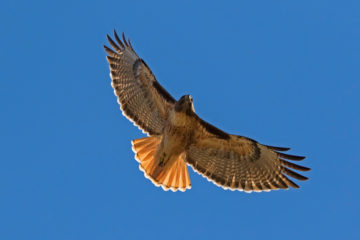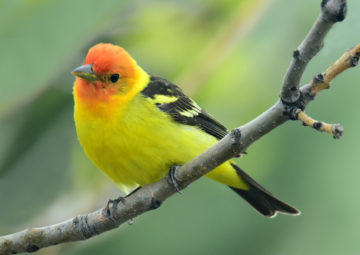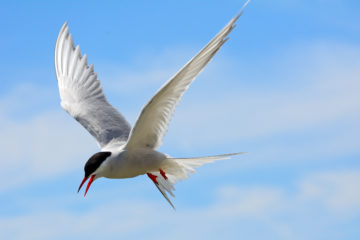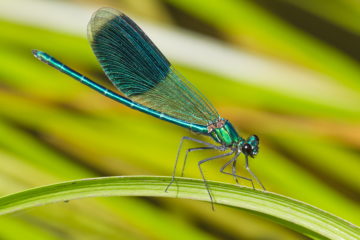by Mark Harvey
Out of the blue, between the sea and the sky,
Landward blown on bright, untiring wings;
Out of the South I fly –Maurice Thompson

One of my sisters who is a wildlife biologist often leaves the cinema with an entirely different take on the virtues of any particular movie if it’s set on a natural landscape. Be it an epic love story on the plains of Montana or a character-driven film taking place in the Cascade mountains of the northwest, she and her biologist friends see things through a different lens than you or I. While we might be moved by a love story between a cabin dweller scrapping out an existence while courting a fetching lass from an adjoining homestead, they often leave the same film frustrated and grouchy about how badly and unscientifically the natural world is cast.
“Did you hear that bald eagle?” They’ll say. “That’s not the sound a bald eagle makes! They obviously dubbed the call of a red-tailed hawk over that bald eagle. Who’s going to miss that?”
Well, about 99% of the audience still dabbing their eyes from the happy ending when the homesteaders requite their epic love on the epic landscape.
One thing that seems to really drive my sister and her biologist friends mad is when the director gets the phenology wrong. Phenology, to remind you, is the natural cycle and timing of nature. For example, every spring there is a certain pattern and time frame of flowers blooming, birds returning to the north, insects hatching, and bears coming out of hibernation. So when a film director has the male hero shyly offering flowers to his love interest in one scene and bodice busting in the next, my sister and her crew will cast a clinical eye on the Indian ricegrass and its development between scenes.
If the scenes were filmed out of order, they will leave the theater fuming at the advanced maturity of the grass in the first scene compared to the immaturity of the grass in the second scene. “Well that was weird,” they’ll say. “How did that grass magically go backward in time three weeks? It’s as if he tore her clothes off and then gave her the flowers. How stupid is that?”

I don’t have the training to describe the subtleties in spring’s phenology, but since I do spend most of my life outdoors, I can’t help but notice some of the patterns as the days get longer. Phenology is a tricky business and its complexity is rivaled by the intricacies of weather and climate. And for millions of years, the patterns and timing of phenology have been defined and delicately calibrated by weather and climate. Since birds are the harbingers of spring they are a good place to start. A favorite bird here among birders is the western tanager. The adult male of the species is marked by bright yellow body feathers and red accents on its head. The western tanager has a vast migration route ranging as far north as the Yukon in the summer to Guatemala in the winter. The most reliable variable that signals northern migrations in the spring and southern migrations in the fall is temperature. There is a weaker correlation to photoperiodism (the change in daylight hours) for migratory birds, but the rise in temperature in the spring and the falling of temperature in the fall is what has been shown to be the motivating factor.
The most remarkable migration takes place with the Arctic tern (Sterna paradisaea), a bird that travels close to 45,000 miles round-trip every year between the Antarctic and the Arctic regions, some traveling almost 60,000 miles. Since the earth’s circumference is only about 25,000 miles, you may wonder why the extra-long journey. Using tracking devices, scientists have discovered that the terns take very convoluted routes to take advantage of prevailing winds and intermediate feeding grounds. Since a tern lives to about 30 years old, that means over the course of its lifetime it travels well over a million miles or more than two round trips to the moon.

Whether it’s the single-hemisphere migration of the tanager, or the bi-polar voyages of the terns, scientists have long wondered how in the heck (more like how the f—) these birds manage to travel such long distances with pinpoint accuracy. When you consider that Americans often get lost in the Las Vegas Convention Center or migrating from the slots to the crap tables in the Bellagio casino, it really does beggar belief that a tern can accurately travel from a northern colony in Norway’s Spitsbergen to their southern colony in the Antarctic.
It’s this otherworldly navigation that has challenged the world’s best scientists to figure out how they do it. And this is where it gets weird. Scientists speculate that birds use the sun and stars and even olfactory glands on their beaks to navigate. But recent work has scientists believing that birds can see the earth’s magnetic field. That’s where quantum physics and what’s termed “quantum entanglement” come into play. Quantum entanglement sounds like the fallout from marrying into a large Catholic family, but among physicists it is the departure point from classical physics.
The fortune-cookie version of quantum entanglement is that two particles generated at the same time (known as radical pairs) will forever be linked and correlated when it comes to their net spin, no matter the distance between the two particles. So if one particle spins clockwise at a certain velocity, the other will spin counterclockwise at the same angular velocity no matter where the two are in the universe or the distance separating them. The original idea was too much for even Einstein who called it spukhafte Fernwirkung, which in German means “spooky action at a distance.”
Back in the 1970s, the German-American scientist Klaus Schulten first speculated that through quantum entanglement within a bird’s eye the earth’s magnetic field might be sensed or visualized by migrating birds. Since then scientists theorize that the protein cryptochrome in the bird’s retina allows for what is described in Scientific American as an ongoing “quantum waltz” between the earth’s magnetic field and the bird’s eye. That a bird might sense such a weak force through its eyes promises to give ornithologists years of interesting research.

One bird that does not migrate is the common raven, one of my favorite birds. When fall comes and most of the birds here in western Colorado fly south to escape winter, the homely raven in its oily black union suit stays in place, unflinching with the cold. He seems to say, “What’s the fuss all about, why all the travel south, are the winters that difficult?”
I find it hard not to anthropomorphize Ravens. With their no-nonsense black feathers (male and female), their lack of any colorful accessorizing, blunt beaks, and sturdy builds they are the roughneck workers of the bird world. They don’t seem to be picky about what they eat, and are often the first to take advantage of carrion. You’ll see hordes of them at landfills neatly blending in with the 30-ton Caterpillar compactors rumbling around. Some of them march around landfills as if they manage the place.
And, again, probably anthropomorphizing here, but when the other birds return with the fairer weather, the staunch Raven seems a little disdainful as if to say, “This phenology is for the birds.”
Phenology and phrenology are often mixed up in common parlance. If your friend, just back from an extended trip to Los Angeles, starts exploring your head with his/her/their fingers and making broad statements about your future as president of the United States, that’s phrenology. It was very popular in the 19th century and something even Queen Victoria and Prince Albert took seriously. In the heyday, phrenologists claimed to be able to discern qualities such as conjugality and combativeness based on the shape of your head. Some would consult a phrenologist before entering marriage or making big hires. They must have been knuckleheads! Ambrose Bierce called it “the science of picking the pocket through the scalp,” and the English geologist Adam Sedgwick called it “that sinkhole of human folly and prating coxcombry.” Back to phenology.
Like so many other things, climate change is throwing off the swiss-watch timing of bird migration. When it comes to timing, especially on the migration north to nesting grounds, birds have to get it right. If they arrive at their nesting grounds too early, there will not be abundant food and if they arrive too late, the peak of food supply will have passed. Over millions of years, the timing between plants blooming, insects migrating and hatching, and birds flying north has been perfected. Mostly it is temperature driven although there is also a weaker photoperiodism involved in some cases.
Spring as measured by the development of plants is coming earlier to much of North America by as much as weeks in some cases. Some species of birds appear to be adapting to the earlier springs but others are not and a “mismatch” is occurring. A recent multi-institutional study of 48 species of songbirds of North America shows that the average time between spring plant growth on a continental scale and the average return dates across the species is increasing every year by about half a day. Stephen Mayor, the ecologist who led the study, calls the increasing gap a new version of a “silent spring.” Of the 48 species studied by Mayor and his colleagues, nine species are clearly not keeping pace with the earlier springs. Those species include great crested flycatchers, indigo buntings, scarlet tanagers, rose-breasted grosbeaks, eastern wood-pewees, yellow-billed cuckoos, northern parulas, blue-winged warblers and Townsend’s warblers.
Part of the reason that some birds are mismatching their migration is that climate change and temperature shifts are not happening in a perfectly uniform fashion across the globe. And migrating birds of North America really have three zones to consider: their winter grounds in the south, the territory they need to cross on the migration, and their nesting grounds in the north. Once upon a time not long ago, the birds were nicely synchronized with the three zones. But as these zones change climatically—often at different rates—the world for birds is getting out of whack.
Some birds are even changing the patterns of their migration from a south-to-north axis to an east-to-west axis. Some members of the species Richard’s pipits, a bird that traditionally migrated between south Asia and Siberia have been found to now migrate between southern Europe and Siberia. Researchers suspect the warmer climate in southern Europe has made it a suitable wintering ground.
One migration that is sometimes overlooked and less understood is the migration of insects. As Janet Marinelli points out in an article for the National Wildlife Federation, every year, trillions of insects migrate north and south depending on the season. Some travel hundreds of miles and some even thousands of miles. Painted Lady butterflies, for example, travel from the Sahara desert to the arctic circle every year, a nine-thousand-mile trip. Recently scientists have discovered that somewhere in the neighborhood of 3.5 trillion insects travel annually through the United Kingdom region alone. As insects are partially composed of nitrogen and phosphorous, the annual migration represents huge energy and nutrient flows between the north and the south.

Entomologist Mike Quinn has documented 71 species of migrating insects in North America, most being butterflies, moths, and dragonflies. As some insects are pollinators, climate change can lead to mismatches between plants dependent on pollination and the insects. While some pollinators seem to be adjusting to climate change at the same rate as the plants dependent on them, others are showing phenological shifts—both temporal and spatial– that do not synch up properly. This mismatch imperils both the plants and the pollinators dependent on the plants for food.
I always welcome spring with open arms as I don’t winter very well and loathe winter’s gloaming. Here in Colorado’s high country, the signs are there: a few buds on the trees, a few greening blades of grass, the increasing turbulence of streams and rivers from spring snowmelt, a few early returning birds, and the occasional flying insect. And of course people—whose legs apparently haven’t seen the sun since October–wearing shorts and buying charcoal lighter. There are subtle shifts every year in how it all pieces together or doesn’t piece together. In the dark months before spring, I try to emulate my friend the raven who spends the winters here, far more hearty in the face of the same gloaming than I am. I tell myself if he can do it, so can I. But unlike the imagined sentiments I’ve projected on the raven, I hold no contempt for those birds and butterflies smart enough to have gone to Mexico back in October. Bird brains or not, they’re smarter than I am!
